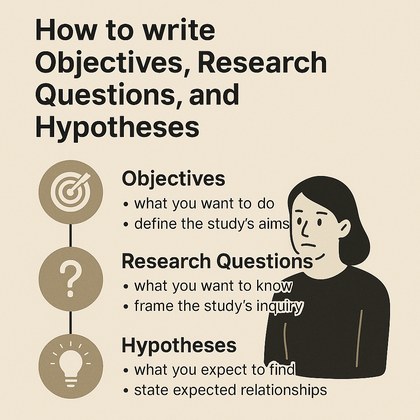Objectives, research questions and hypotheses are the blueprint of any thesis. Written clearly, they guide every chapter — from literature review to methods and analysis. This guide shows how to draft each component with examples and common mistakes to avoid.
What are research objectives?
Objectives state what you intend to do. They should be SMART: Specific, Measurable, Achievable, Relevant and Time-bound. A useful structure is one general objective supported by 3–6 specific objectives that are measurable.
General vs Specific
General objective summarises the overall aim. Specific objectives break it into actionable pieces.
Example general objective: To examine the effect of digital learning tools on undergraduate academic performance.
Example specific objectives:
- To measure frequency and types of digital tool usage among students.
- To examine the relationship between digital tool usage and academic scores.
- To compare tool usage across urban and rural institutions.
- To identify barriers to effective use of digital learning platforms.
From objectives to research questions
Each specific objective becomes one or more research questions. A good research question is focused, answerable and measurable.
Examples matched to objectives above:
- RQ1: How frequently do undergraduate students use digital learning tools?
- RQ2: What is the relationship between digital learning tool usage and academic performance?
- RQ3: How does tool usage differ between urban and rural institutions?
- RQ4: What challenges do students face in using digital learning platforms?
Formulating hypotheses (quantitative studies)
Hypotheses are testable statements derived from theory or prior findings. Always state both the null (H0) and the alternative (H1) when preparing for statistical tests.
Example:
H0: There is no relationship between digital tool usage and academic performance. H1: Higher digital tool usage is associated with higher academic performance.
Directional vs Non-directional hypotheses
Use directional hypotheses if prior research suggests the direction (e.g., positive effect). Use non-directional when literature is mixed.
Aligning objectives, questions & hypotheses
Alignment is crucial. For each objective, show the research question, variables, intended analysis and possible hypothesis. This makes it straightforward to design instruments and pick statistical tests.
Choosing the right verbs
Use clear action verbs in objectives: assess, compare, evaluate, estimate, measure. Avoid vague verbs such as "explore" unless you explain how you will operationalize them.
Common mistakes and fixes
- Too many objectives: reduces focus — keep 3–6.
- Vague wording: replace "study" with specific verbs.
- Mismatched methodology: qualitative methods cannot test hypotheses — align your method and objectives.
- Non-measurable questions: ensure each question can be answered with data.
Mapping to analysis
For each question, specify the variable type (continuous, categorical), sample size needs, and intended tests (t-test, ANOVA, regression, SEM). Example: comparing means across two groups → t-test or Mann–Whitney; predicting outcome → regression.
Practical checklist
- One clear general objective and 3–6 specific objectives.
- Research questions matched to each specific objective.
- Hypotheses only for quantitative components.
- Analysis mapping and tentative sample size.
- Supervisor sign-off and ethics plan.
Closing note
Clear objectives and aligned questions make data collection and analysis efficient and defendable. If you want, we can convert your draft objectives into measurable variables, design instruments, and map them to analysis plans.

